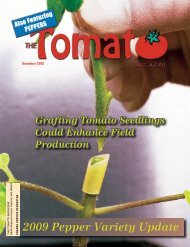Integrity as a Way of Life - Columbia Publishing & Design
Integrity as a Way of Life - Columbia Publishing & Design
Integrity as a Way of Life - Columbia Publishing & Design
Create successful ePaper yourself
Turn your PDF publications into a flip-book with our unique Google optimized e-Paper software.
where his son, Fay, eventually followed in his<br />
footsteps. Today, there are three generations<br />
<strong>of</strong> the family that continue to farm: Dick<br />
Corn, Fay’s son; Bruce Corn, Dick’s son; and<br />
Dan Corn, Bruce’s son. All three farm independently<br />
and grow onions and other crops.<br />
Dick and Dan both have approximate 650<br />
acres under production, while Bruce farms<br />
approximately 700 acres.<br />
The Corns grow multiple crops, but<br />
despite the ups and downs <strong>of</strong> the onion industry,<br />
recognize that over the long haul, onions<br />
have been good to them. Bruce had 80 acres<br />
<strong>of</strong> onions this year, Dan, 70, and Dick, 60<br />
acres.<br />
Most <strong>of</strong> the ups and downs in the marketplace,<br />
at le<strong>as</strong>t for the Tre<strong>as</strong>ure Valley, are not<br />
due to more acres being planted each year,<br />
Bruce insists. The real problem is widespread<br />
yield variability.<br />
“Over the p<strong>as</strong>t five years in Malheur<br />
County, I doubt that the number <strong>of</strong> acres<br />
h<strong>as</strong> varied more than 1,000 to 2,000 acres,”<br />
Bruce notes. “But the yields have swung<br />
from <strong>as</strong> low <strong>as</strong> 400 cwt per acre up to 900<br />
and even 1,000 cwt. So, you can see what<br />
that does to a market. The <strong>Columbia</strong> B<strong>as</strong>in is<br />
in a similar situation. Production there is very<br />
similar to the Tre<strong>as</strong>ure Valley, and between<br />
the two are<strong>as</strong>, we largely determine the outcome<br />
<strong>of</strong> the winter storage market.<br />
Mother Nature Rules<br />
“How can you plan for swings like that?”<br />
he <strong>as</strong>ks. “You work just <strong>as</strong> hard each year.<br />
The 2006 crop w<strong>as</strong> very poor in terms <strong>of</strong><br />
yield, but for those with open onions brought<br />
record prices. On the other hand, the 2007<br />
crop produced unheard <strong>of</strong> yields and ended<br />
up an absolute dis<strong>as</strong>ter. When it comes down<br />
to it, there isn’t much you can do to control<br />
Mother Nature.”<br />
B<strong>as</strong>ed on their experience with the<br />
2007 onion crop, when the bottom literally<br />
dropped out <strong>of</strong> the market, all three cut their<br />
onion acreage slightly and this year grew<br />
more corn and wheat.<br />
Dating back to the family’s first involvement<br />
in agriculture, sugar beets have also<br />
been a family tradition. Unfortunately, the<br />
margins on sugar beets today are also very<br />
thin. Over the p<strong>as</strong>t couple <strong>of</strong> years, at le<strong>as</strong>t,<br />
the returns on corn and wheat have proven<br />
more rewarding.<br />
“We’re still hanging in there with our<br />
beets, and I mean literally hanging on with<br />
10 Onion World<br />
our finger nails,” Bruce grimaces. “Beet<br />
returns have not been good. While all <strong>of</strong><br />
our input costs—fuel, fertilizer, equipment,<br />
etc.—are going through the ro<strong>of</strong>, we have a<br />
‘sharing’ type contract, and the price <strong>of</strong> sugar<br />
h<strong>as</strong> not gone up that much.”<br />
First Crop <strong>of</strong> Onions<br />
Bruce grew his first crop <strong>of</strong> onions in<br />
1977 and w<strong>as</strong> the first in the family to do so.<br />
“Paul Skeen, a good friend and long-time<br />
onion grower, helped me get started with a<br />
few acres,” Bruce remembers. “Dad (Dick<br />
Corn) grew his first onions in the early 1980s<br />
and Dan in 2005 on ground he had rented<br />
from a neighbor. Three years later, he ended<br />
up purch<strong>as</strong>ing the place.”<br />
Dan is especially grateful to Dirk DeBoer,<br />
a well-know farmer in the area, who, in<br />
addition to being a good friend, helped him<br />
through the learning curve and also introduced<br />
him to growing shallots. Technically,<br />
DeBoer is retired from full-time farming but<br />
continues to be very active in other ventures,<br />
including advising with Dan on the shallots.<br />
He also h<strong>as</strong> introduced him to the benefits <strong>of</strong><br />
using drip irrigation. All 45 acres <strong>of</strong> the shallots<br />
are under drip.<br />
“Shallots are touchier to grow than<br />
onions,” Dan admits. “Dise<strong>as</strong>e resistance<br />
isn’t <strong>as</strong> good and there is very little room for<br />
mistakes. Learning how to grow a quality<br />
crop h<strong>as</strong> been “pretty steep.”<br />
“This is my second year <strong>of</strong> working with<br />
Dirk on shallots. Both years, we’ve made<br />
a few changes in our production practices,<br />
attempting to be more productive. This year<br />
we went to using intense beds with drip irrigation.<br />
Next year, more changes are in the<br />
works.”<br />
The shallots are contracted with DeBoer<br />
Farms, Dirk’s business. Dan handles the<br />
production side, while Dirk markets the crop.<br />
Most <strong>of</strong> the shallots are shipped to California<br />
and then on to other markets.<br />
Interesting Year<br />
On the onion side <strong>of</strong> the business, it h<strong>as</strong><br />
been an interesting year, according to Bruce<br />
and Dan. After a delayed start in the spring,<br />
the summer se<strong>as</strong>on went well.<br />
“Overall, the year w<strong>as</strong> good,” Dan says.<br />
“Our hybrids are average or a little bit above.<br />
Maturity h<strong>as</strong> been a big problem. A late September<br />
rain storm came through two weeks<br />
after the crop w<strong>as</strong> lifted and nearly ready for<br />
storage. Days later, more rain fell, slowing<br />
down the harvest and leaving us biting our<br />
finger nails.”<br />
In early October, the Corns were racing<br />
against the clock, worrying over whether they<br />
could finish the harvest before the first deep<br />
frost hit. Also in the back <strong>of</strong> their minds w<strong>as</strong><br />
concern over adequate curing time, important<br />
in avoiding Botrytis neck rot in storage.<br />
The Top Air Topper Loader used to harvest<br />
the crop seems to help with the drying<br />
down process, Bruce says. Since moving<br />
in that direction, storability <strong>of</strong> the crop h<strong>as</strong><br />
improved. There appears to be less damage<br />
to the onions and, hence, reduced opportunity<br />
for pathogens to penetrate the bulbs.<br />
“Our onions have good skins,” Bruce<br />
says. “We have more mediums than normal.<br />
There is not much oversize. Most <strong>of</strong> our crop<br />
are jumbos, 3 ½ inches in size.”<br />
With this year’s acreage down and the<br />
growing se<strong>as</strong>on slightly shorter than normal,<br />
the family is hopeful <strong>of</strong> a more pr<strong>of</strong>itable<br />
year. Most <strong>of</strong> their onions are contracted to<br />
various packing sheds. The Corns do business<br />
with a handful or so <strong>of</strong> different facilities,<br />
depending upon needs at the time.<br />
Cautiously Optimistic<br />
“There were a few here that were fortunate<br />
and did really well in 2006, when open<br />
market onions were in short supply,” Dan<br />
says. “However, Dad and I both feel that<br />
2008 is shaping up to be more like 2005,<br />
when there w<strong>as</strong> an average crop. We had a<br />
decent, but not fant<strong>as</strong>tic, market that year,<br />
and we would like to see something similar<br />
happen again this year.”<br />
On the production side <strong>of</strong> their business,<br />
the Corns have concerns about Iris Yellow<br />
Spot Virus and the damage it can cause, but<br />
did not experience any significant damage to<br />
their onions this year.<br />
“We were fortunate to have excellent<br />
thrips control,” says Bruce, “but you can<br />
never be sure that by following the same<br />
cultural practices next year you will see the<br />
same outcome. There are new chemicals<br />
coming out that may help, but all <strong>of</strong> us have<br />
to be constantly vigilant. Once you feel you<br />
have things figured out, just wait until next<br />
year. Something new will come back to bite<br />
you.”<br />
The number one weed problem is yellow<br />
nutsedge, which is rearing its ugly presence<br />
almost everywhere.








